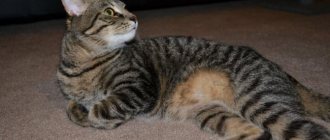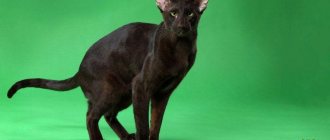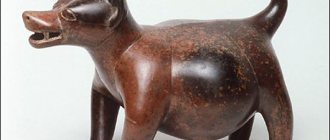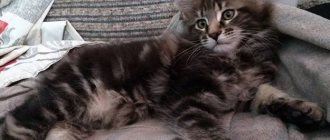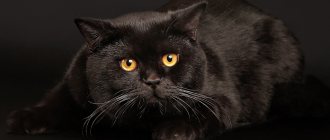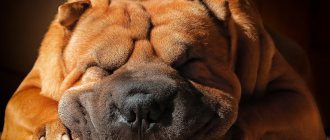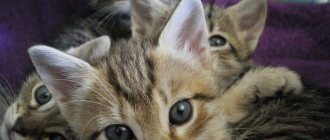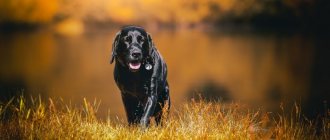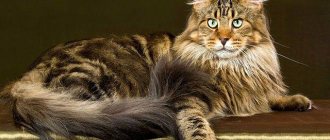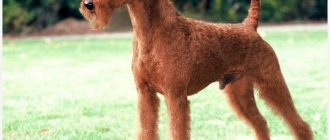10666Marina Kharlova
1
The homeland of the Maine Coon breed is North America. Thanks to the harsh climatic conditions, representatives of this breed acquired their own unique habits, character and characteristics. The Maine Coon's character is distinguished by calmness and balance, curiosity and friendliness, self-reliance and independence. At the same time, it is an active and playful animal, preferring open space with hills.
Maine Coons have a sociable character, they are endlessly devoted to their owner and adore children, they easily find a common language with all household members and guests. The physical activity of these cats does not decrease over the years, so they need free space for games and entertainment.
Maine Coon cat: history of origin
The breed's name means "Manx raccoon" because the breed's first recognized color was "black tabby", resembling a raccoon.
The breed arose through natural selection in the northeastern United States. Cats were kept on farms to catch mice, and since large cats cope better with these duties, the owners selected the largest cats. And the rest was done by nature, or more precisely, by the climate. Cold winters and strong winds give an advantage to cats with the thickest fur.
In 1861, the Maycoon cat Captain Jenks of the Marine Cavalry made a splash at cat shows in New York and Boston. Tassels on the ears, a tender heart hiding behind a serious and impressive appearance, made the breed recognizable and popular until the Persians came into fashion by the beginning of the 20th century.
Important! The breed was forgotten, so the club of Maine Coon cat lovers, created in 1953, had difficulty finding breeders.
The farmers came to the rescue. They didn't care about the whims of fashion. The giant cats coped with their duties perfectly, but the climate of the island remained the same harsh, so it was difficult for smooth-haired cats to survive there.
Other versions: from fairy tale to reality
Experts are a little skeptical about the romantic legends about the origin of the popular breed. Most felinologists adhere to the version that the history of the breed began with the crossing of local short-haired cats with their long-haired relatives, brought by sailors to the American continent from Europe.
Official felinology holds the following opinion about the Maine Coon breed: the first Maine cat was born from a union between a long-haired forest cat that arrived from Europe with the Viking pioneers, and a North American aboriginal cat, which was not yet domesticated. Centuries passed, and gradually, under the influence of the harsh climate of the East Coast, the standard of the Maine Coon breed was formed - powerful, handsome cats, distinguished by magnificent hair, thick and silky, capable of protecting from frost and cold winds, as well as an imperturbable Nordic character. Today, the Maine cat is one of America's national treasures, and rightly so.
Aborigines of the Isle of Man
All breeds can be divided into two types:
- artificially bred;
- Aboriginal.
Artificial breeds were formed by people through crossing, but with native ones everything is a little more complicated. In a certain environment, a certain population is formed, it adapts to the climate, consolidates its main features, and the fittest individuals survive and develop.
Kosei cat, the first representative of the breed presented at the cat exhibition in 1895.
The native cats, from which the modern breed began, developed in harsh conditions. The North American state of Maine is characterized by cool summers and long, cold winters. In such a difficult climate, the ancestors of modern cats had to lead a predatory lifestyle in order to compete with other animals.
The cats were distinguished by a long, dense fur coat, a fluffy tail and a strong, muscular body. A thick fur coat provided protection in winter, and long legs helped to move through the snow. The huge tail allowed them to sleep on snow cover and in cold burrows. By wrapping themselves in their tails, they protected their sides and belly from freezing. Long mustaches helped hunters navigate at night; the ancestors of the Coons ate mainly birds and rodents - sharp teeth served as good weapons.
Modern Maine Coons sometimes resemble their relatives. Some animals have powerful fangs protruding from under the upper jaw. The elongated snout allowed predators to hold large prey.
For a long period of time they lived near farms, protecting supplies from rodents. Villagers viewed cats as hunters and were of little interest to their pets' appearance. Maine Coons were considered excellent rat catchers; residents tamed the animals to protect barns from mice. Gradually, the appearance of American cats began to gain popularity. In addition, the animals were distinguished by their friendly nature, and they began to be appreciated. Events took place 150 years ago. The Kuna began to spread deeper into the continent.
Reliable information about the breed begins to appear in the mid-nineteenth century. At this time, a cat exhibition is taking place, at which one participant presents a new breed - the “raccoon cat”. The large, long-haired cat quickly gained popularity.
General characteristics and description of Maine Coon cats
6 interesting reasons why you should get a Maine Coon
Maikun cats are larger than cats; a cat’s weight can reach 15 kg, and a female cat’s weight can reach 8 kg.
Interesting: The longest Maine Coon had a length from nose to tip of tail of 123 cm. The largest living one is only 3 cm shorter. Its weight is 14 kg. The cat is only 3 years old, so he still has everything ahead of him.
Maine Coon: advantages of the breed
How to raise a truly big cat and what determines the size of a Maine Coon
Perhaps everyone who chooses a representative of this breed as a pet secretly or openly dreams that the kitten will grow into a huge cat weighing at least 10 kilograms. It’s no secret that Maine Coons are often purchased precisely because of their outstanding dimensions.
It is impossible to say for sure in advance whether the touching baby will grow into a giant, but nevertheless there are still a number of factors that can play a decisive role in the animal’s appearance. These include:
- genetics. Large parents are more likely to produce similar offspring. Therefore, before buying a kitten, or even better at the stage of planning the mating, it is advisable to get to know the baby’s mother and father. Moreover, look at both of them live, and not in photographs, from which it is difficult to judge the exterior, especially if the person is not a professional and is familiar with the breed from descriptions on the Internet;
- gender Please note that cats are always larger. Cats are distinguished by a more elegant and graceful physique;
- good breeder. You need to be extremely careful when choosing a nursery from which to adopt a new family member, since the appearance and, most importantly, the health of the future pet depends on how responsibly the owner of the parents treats his business. A competent breeder is not just an amateur who bought animals of different sexes and began to cross them to produce offspring for sale, but a professional and enthusiast of his business, conducting serious breeding work. With the right approach, you will definitely be invited to visit to meet and communicate with the animals, as well as look at the conditions of their detention;
Important! Maine Coons are late maturing cats. Kittens of this breed should not be separated from their mother early. A normal breeder will never give up a baby before 3-3.5 months. So you’ll have to wait a little, but then you’ll get an absolutely adequate, well-socialized animal trained in all the wisdom of a cat.
- proper care and feeding. And already at the stage of pregnancy of the cat. Be sure to ask the breeder what the expectant mother ate and whether she was given any medications. A conscientious breeder will not hide this information from the potential owner, since he is more interested than anyone in ensuring that the kitten ends up in good, caring hands.
Maine Coon breed standard
Korat cat - description of cats and kittens of this breed
In addition to their impressive size, Maine Coons are distinguished by their strong muscles, wide bones, rectangular build and harmonious proportions. They look like this:
- medium-length muzzle with high cheekbones and a massive chin. The nose is not long with a smooth transition from the forehead to the muzzle. The ears are set high and have tufts. The distance between them is equal to their width. The eyes are large, round, often slightly slanted. The color of the eyes can be amber or green, and the distance between them is also equal to their width;
- Maine Coon paws are powerful and muscular. There are tufts of hair between the toes;
- the tail is long, conical in shape with a pointed end. Its fur is long and flowing;
- The collar is strongly pronounced. Under the long outer hair there is a thick soft undercoat.
Maine Coon cat color
Maine Coons can come in a wide variety of colors. Only brown, purple and chocolate shades are unacceptable. Siamese and Abyssinian colors are also not included in the breed standard. But the white patterns on the muzzle, chest, paws and belly fit well into it.
Character and behavior of Maine Coons: advantages and disadvantages
Maycoon cat breed: characteristics
For Maykuna cats or cats, the characteristics are as follows:
- very friendly;
- have excellent memory;
- able to understand speech.
Description of typical behavior for the breed
Maine Coons are quite trainable; they understand most commands perfectly. These are the real intellectuals among cats. Their actions are logical and consistent. Most of all, Maine Coons love to indulge in contemplation, sitting in a comfortable chair, on a windowsill or on a sofa. They also like to watch TV, especially programs about animals or cartoons.
In childhood, kittens are very playful, but even an adult cat will not deny himself the pleasure of chasing a piece of paper on a string, chasing a ball or playing with a rag “mouse”. The curiosity of these cats knows no bounds. They are required to study every new object in the house. But in general, an adult Maine Coon cat is very lazy and contemplative.
What is special about this breed?
Maine Coons are characterized by an exceptional sense of self-esteem and good manners. They do not allow themselves to descend to begging, do not climb into someone else's bowl and do not climb on the table.
Interesting: It is extremely rare to hear meowing from them; instead, they utter long phrases with rich intonations. The sounds made by Maine Coon cats are similar either to human speech or to bird trills. They seem to love their voice to the point that they enjoy it themselves.
Maine Coons are very peaceful, affectionate and friendly. These are very independent and independent cats, so they definitely need to have their own place where they can be alone with their experiences. And yet, most of all, they need to be close to their owner, to observe what he is doing. They will not interfere in business, because they are very delicate and unobtrusive.
Despite their laziness, these giants need space to play, which is problematic in a small city apartment, so they love trips to the country, where they can climb trees to their heart's content. Flowers and garden beds will not be damaged if you clearly explain to your Maine Coon where he can play and where he should not. If he feels that he is guilty of something, he will apologize to the owners, poking his nose into the hand and looking into the owner’s eyes.
They love to play until they are old and enjoy performing acrobatic stunts. They need movement, although at first glance they like to sleep most of all. They can do this anywhere in the most incredible or touching, but always comfortable position. They love to stretch out to their full height.
Content
The Maine Coon is not an ordinary breed. Due to their physiological characteristics, they require somewhat higher maintenance costs than cats of more modest sizes.
When planning to get a little coon, many people wonder how much kittens cost. Prices for purebred animals from good nurseries start from 20 thousand rubles (if you are very lucky) and can reach 100 thousand and above - depending on the title of the parents and the objectives pursued by the buyer. Naturally, a kitten of the so-called pet class, which is destined to become just a pet, will cost several times less than a candidate for a successful exhibition career, although both of them can ultimately grow into luxurious giants with outstanding breed characteristics.
However, it is not enough just to buy a kitten from wonderful parents, even for a lot of money. The main thing is to provide him with decent care and maintenance.
Representatives of this breed feel great both in a city apartment and in a country house. Of course, the second option is ideal due to more free space and the ability to regularly breathe fresh air. If you live in your own home, your number one task is to provide a safe walk for your pet. Despite their impressive size and harsh appearance, these cats are completely unsuited to life on the street and will not be able to protect themselves in case of danger. They are not very agile, and they don’t know how to fight at all. The times when they protected North American farms from rodents are long gone, and the modern Maine Coon is a friendly companion, not a cunning and resourceful hunter. The best thing you can do for your four-legged mustachioed friend is to build a spacious enclosure, closed on all sides, with access directly from the house. Place logs and branches of various configurations and sizes inside, and your pet’s gratitude will know no bounds. Such a walking area will provide your pet with the necessary amount of fresh air and sun, and will also satisfy the need for games and movement.
If you are not the happy owner of your own house in the village, then it is quite possible to provide a coon with decent living conditions in a city apartment, but with reservations regarding the dimensions of the new home. Maine Coons have a calm and balanced character, but the kittens are not averse to frolicking, and if you take into account the fact that they remain kittens for up to three years, and their weight by the year can reach 10 kg, then it becomes clear that everything is easily breakable and represents It is better to remove artistic value away.
Also, do not forget to protect your inquisitive pet from falling - never open windows wide if there is a cat in the room! Or place special grilles (not meshes!) in the openings.
To provide the coon with sufficient physical activity, the owner needs to think about purchasing a special play complex for cats. It should be high enough, but stable, with wide, spacious areas, hammocks or houses where the animal can relax and retire. At the same time, such a complex will act as a scratching post, keeping the upholstery of your furniture safe and sound. Such devices can be bought at a pet store or made to order. Many manufacturers have special lines for giant cats. Give preference to these, although they are somewhat more expensive. But your cat is also unusual, isn’t it?
If we talk about nicknames that are suitable for Maine Coons, then such a majestic animal needs an appropriate name. Among boys, Duke, Count, Viscount, Martin, Mars, Admiral, Patrick, Sean, Askold are often found. The girls are called Duchess, Adele, Olivia, Quinn, Stella, Ursa, Martha.
Relationships in the family: to children, to other pets
The Meykun cat easily tolerates a change of environment, the main thing is that the owner is nearby. They are dog-like devoted to their beloved owner, of whom they usually have only one, but they also treat other family members with delicacy and attentiveness.
Note! Maine Coons are polite to strangers, but are wary. They treat frequent guests more simply, but not familiarly.
Maine Coons are very caring towards children. The appearance of a small “kitten” by the owners will make the cat happy. They treat their kittens like fathers, so they don’t have to be removed from the cat daycare. Micon the cat takes part in caring for his offspring with pleasure, clearly being proud of them.
Of the other pets, they easily make friends with everyone. But they may not be able to put up with mice and other rodents. Instinct may well take precedence over all manners. Well, it’s still not worth taking risks with small parrots. If a kitten comes to a house where a bird or a rat already lives, then everything goes peacefully.
They are very touching friends with ferrets, and they can find a common language with dogs. But here it depends more on the dog, a completely impolite and aggressive one can be given regardless of size, but with the rest they can become best friends.
Meikun training
Maine Coon Health
The Maine Coon cat breed is naturally healthy, but there are some peculiarities.
Maine Coon diseases
Maine Coons have dysplasia of the heads of the hip joints. Due to the weakness of the heads, the joint is easy to twist. Proper nutrition helps prevent the development of the disease.
Spinal muscular atrophy is much more dangerous. It causes muscle wasting and weakness. But, fortunately, this disease is now rare.
If you have any health problems, you should consult your veterinarian as soon as possible, as they may indicate the onset of a dangerous disease.
Infections most often occur by eating sick rodents or contaminated meat. Cats can become infected with tuleria from rodents, which begins with fever and apathy, and swollen lymph nodes. A sick animal quickly loses weight, ulcers appear and pneumonia develops.
Hemorrhagic fever begins with high fever, chills and vomiting. Bleeding can be either from the nose or internal, so the disease is very dangerous.
Insufficiently cooked beef can lead to bovine tuberculosis and even deadly spongiform encephalitis. In the latter case, neither boiling, nor freezing the meat, nor drying it will help. Therefore, you should buy meat and dry food from manufacturers who do not skimp on a thorough analysis of the product and the components used in its production.
Health, tendency to disease
Genetic diseases:
- Hypertrophic cardiomyopathy, when the walls of the myocardial ventricles are thickened. It may not show any symptoms, sometimes ending in the sudden death of the pet.
- Spinal muscular atrophy. Characterized by muscle weakness. Leads to atrophy of muscle tissue, shortens the life of the coon.
- Hip dysplasia. Accompanied by frequent dislocations, pain, and mobility impairment. Not life threatening.
Addiction:
- Urolithiasis disease. Reasons: too hard water to drink, incorrect diet composition. The risk of getting sick increases in neutered animals.
- Oral diseases: tartar, stomatitis, tooth loss, bleeding gums. The risk is increased when feeding insufficiently hard natural food.
- Gastrointestinal diseases. Common causes: change of food, unhealthy diet.
Signs of any disease:
- lethargy, inactivity,
- lack of appetite,
- dull coat,
- teary eyes,
- hot, dry nose,
- thirst, vomiting, constipation/diarrhea,
- temperature rise by 1-2 °C (at a norm of 37.5-39 °C).
Caring for Maine Coon cats
Maine Coon cats are very easy to keep. Caring owners will not ignore dirt in the ears; they devote time to caring for the coat.
Maine Coon-5
How to care for your fur
Caring for the fur is absolutely not difficult: brushing your pet once a week is enough. Special and daily attention to its hair needs to be paid only during molting, which occurs once a year. At this time you will have to comb it every 2-3 days. Maine Coons enjoy this procedure, especially if taught to it from early childhood. How to comb:
- First, comb it with a wide-toothed comb; any clumps of hair that come across are carefully sorted out with your fingers until they roll into large tangles and have to be cut off. Do not wet wool pellets with water;
- the next comb should be metal with fine teeth, the ends of which are blunt. Plastic combs electrify the fur and are therefore unsuitable;
- It is best to finish the procedure with a brush with natural bristles. It is easiest for her to get rid of stuck hairs and give her fur a smart, well-groomed look.
Important! If your pet begins to lose hair, you should consult a veterinarian.
This can be a sign of health problems, but is more often due to poor diet.
Feeding Maine Coons
At first, you need to strictly follow the scheme specified by the breeder. Such a radical change of environment and getting used to the owners is already too much stress.
After a month or two, you can gradually introduce him to a different food.
Diet
The best meat is chicken or turkey; beef will also work, but not pork or lamb. Cats need offal products because they cannot synthesize vitamin A, and most of it is in the liver. Microelements and other useful substances are found in abundance in chicken heads, stomachs, and liver. You shouldn’t feed liver too often; too much of the vitamin is just as harmful as too little.
Another necessary food component for cats is taurine. It is found in meat, so they need it in sufficient quantities in their diet. Don't be afraid of high-quality dry food. Premium food contains all the substances a cat needs in optimal quantities and will only bring benefits.
In the medium-class feed, the composition is not selected so carefully, but in economy-class feed, the cheapest products are used, so their quality remains on the conscience of the manufacturer.
Maine Coons are the kind of cats that happily eat vegetables and porridge, especially if they have some meat or fish added to them. Are partial to bread. The more varied the diet, the better. Can't be fried, too fatty. Sweets are useless; cats’ bodies simply cannot digest them, but if you occasionally enjoy a cake, it won’t do any harm.
Feeding
Feeding frequency:
- 3-4 months - 5-6 rubles/day;
- 4-6 months - 4 rubles/day;
- 6 months-1 year - 2-3 rubles/day;
- from a year – 2 rubles/day.
What to feed kittens
Ready-made food: must be labeled “for kittens up to 3 months,” “for kittens up to 10 months/1 g.” Do not mix different types of food.
Natural food. What to feed small Maine Coons:
- cottage cheese (daily);
- low-fat meat (chicken, rabbit, veal, turkey) without skin, bones (daily);
- boiled, pureed vegetables (daily);
- eggs (1 ruble per week);
- boneless fish (1-2 rubles per week);
- children's canned meat and vegetables (several times a week);
- offal (several times a week, starting from 4 months of age);
- vitamin supplements (according to the instructions on the package).
Forbidden:
- ready-made economy class food,
- lamb, pork,
- spices, salt,
- porridge,
- roast,
- tomatoes, eggplants,
- excess seafood, fish (can cause urolithiasis).
Feeding adult Maine Coons
The diet for big Maine Coon cats is similar in composition to the diet for kittens, but the amount of meat must be increased. Include soups and grated cheese in the menu. Add greens and sprouted cereal grains to the food. This cleanses the stomach. Daily calorie content is at least 60 kcal/kg, the amount of protein is 10 g/kg.
Give food at the same time every day. The schedule cannot be violated, otherwise the cat may wake up the owner early in the morning or in the middle of the night, begging for food. If your pet still interferes with your sleep, do not punish him. Chat with him, pet him, but don't feed him. Optimal: feeding before leaving for work and 2 hours after returning home.
Feeding castrated and sterilized animals.
Main problems: possible obesity, development of urolithiasis.
Ready-made food: a special diet is required. You should not give food that contains a lot of phosphorus and magnesium. Follow the dosage to prevent overeating.
The pet must drink enough water (its volume should be 3 times more than the volume of food). If the animal drinks too little, pre-soak the food or give canned food. Alternatively, feed him natural food without mixing it with dry food.
Natural food: exclude sausages, any products processed with salt, food chemicals. Salt should not be added to the food. Diet composition:
- boiled lean meat + broth,
- fish (river only, 1 rub./week),
- boiled offal (1 rub./week),
- eggs,
- low-fat fermented milk products (2-3 rubles/week),
- porridge (rice, buckwheat, semolina, wheat, corn),
- raw and boiled vegetables (carrots, zucchini, pumpkin, beets, cauliflower),
- fresh greens (grass purchased at a pet store or sprouted at home, sprouted cereal grains).
Hygiene and toilet
The kitten's litter box should be placed in a place that is easily accessible at all times. But he shouldn't be in plain sight. Intelligent Maine Coons love to do their business alone. If the kitten did the wrong thing, then you should not scold, much less beat it. This will result in nothing but a frightened cat. You need to show him the puddle and strictly say: “You can’t!”
An adult cat will need a tray of suitable sizes, so in case of a “miss” you should think about the dimensions of the pet. It is better to leave the choice of filler to the cat. The key to cleanliness is the absence of a strong odor, so you need to clean the litter box at least once a day.
Choosing a kitten, care, education
It is first recommended to obtain basic knowledge about cats, visit exhibitions and nurseries. Study the description of the Maine Coon breed, listen to reviews from breeders. Classes of kittens of the same litter:
- shows - exhibitions;
- breeding - breeding;
- pet - for home (cannot be bred).
If the mating is registered, the kitten must have a pedigree; class does not matter. The baby is taken from the mother at the age of 12 weeks.
Choice
Give preference to a large, active animal. The kitten must have:
- sparkling eyes,
- sparkling fur,
- "box"
- ear tassels,
- long ponytail.
Pay attention to the mother cat, she should look well-groomed and healthy.
Care
The kitten will need:
- 2 bowls (for food, water), it is better to choose earthenware or ceramic dishes;
- toilet, filler;
- scratching post;
- bed;
- toys;
- game complex.
Place the bowls together (on the kitchen floor), preferably on a tray. Place the tray in a secluded place, optimally in the bathroom. Clean the toilet at least once a day. Block loopholes into secluded places (under a sofa, closet, etc.). When cleaning up feces left in the wrong places, use an odor neutralizer.
The bed should be located where no one will disturb the kitten. However, he himself will choose where it is better for him to sleep. Play complexes are sold in pet stores. You can adapt homemade horizontal platforms installed at different heights.
Upbringing
Aimed at preventing the development of bad habits. It is necessary for the kitten to be accustomed to:
- to the toilet,
- rules of conduct,
- procedures of combing, bathing and others.
Teach care procedures after play, when the baby gets tired and relaxes. At first it will be an imitation of cutting, combing, and examining. Gradually increase the time of tactile contact. Always give your kitten a treat at the end.
It is recommended to accustom your coon to a hair dryer:
- Turn on the hair dryer when the kitten is eating, and gradually move the device closer to it.
- Keep the device nearby, the air stream should not hit the muzzle.
- Direct a stream of cool air at your pet (for a few seconds).
- Day by day, increase the duration of exposure to the hair dryer.
It is important to immediately establish a good relationship with the coon; you should not perceive him as a living toy. It is strictly forbidden to poke, hit, or use other aggressive methods. Education should be based on the principle of “strict but fair.” To stop your cat from scratching furniture, jumping on tables, and pooping in inappropriate places, use a spray bottle of water.
Toilet training
Toilet training doesn't take long. Keep an eye on the kitten after feeding, and if it becomes restless, put it on the potty. Don't let go until it's empty. The excrement must be removed immediately. Maine Coons are known for their cleanliness; if the toilet is dirty, the pet can “visit” another place.
Bathing
Maine Coons love this procedure. Among them there are those who like to take a shower with their owners, but still you should not bathe Maine Coons more than twice a month. If you brush frequently, it is enough to bathe once or twice a year. Before bathing, the coat should be thoroughly combed. You need to put a towel on the bottom of the bath, then your paws will not slip. Apply shampoo with gentle movements, then rinse with a shower. If you get used to using a hair dryer, you can reduce wool drying to 10-15 minutes.
How to bathe a cat
Nutrition
There is no special nutrition for these animals; it is enough to feed the animal in a balanced manner so that it receives all the necessary vitamins, minerals and other trace elements. Ideally, an adult pet should be fed 3 times a day, but two meals a day are also allowed. What to feed Maine Coon cats: natural or prepared products - this is, of course, everyone’s business. Advantages of ready-made food:
- long-term storage;
- saving your own time;
- variety of finished product (you can buy food for a kitten, for a pregnant cat, for an elderly cat, etc.);
- balanced (premium food contains all the necessary substances required for the animal).
If you decide to feed your pet homemade food, then you should definitely consult with an experienced veterinarian who will create the correct diet for Maine Coon cats and include all the necessary elements. Also, do not assume that feeding homemade food is an economical option. In both cases, the financial investments will be approximately the same.
Any cat is, first of all, a predator that simply needs meat products. What can you feed a Maine Coon:
- Meat: poultry, poultry offal, beef, beef offal, lean veal;
- Dairy products: milk, cottage cheese, natural yogurt, sour cream no more than 15% fat, cheese;
- Porridge: buckwheat, oatmeal and multigrain;
- Fish and seafood should be included in a cat’s diet no more than once a month;
- Eggs, namely the yolk, are good for the body, but not more than 2-3 times a month;
- Vegetables other than potatoes and eggplant, only if the cat eats them;
- An herb that helps cleanse the body.
Castration and sterilization: when should surgery be performed?
This operation will not harm the health or character of the Maine Coon at all. On the contrary, an animal free from worries about finding a partner devotes more time to its owner, looks better and lives longer.
Important! It is best to carry out this operation before one year of age. At six months the body is already fully formed, and it is easier for a young animal to undergo surgery.
Castration is often carried out in a foster home so that the person purchasing a kitten that does not meet the breed standards does not pass off its offspring as a Maine Coon.
Buying Maine Coon kittens
It is best to buy a Maine Coon kitten from trusted breeders.
How to buy a Maine Coon cat from a breeder
If you want to get a purebred kitten, then it is best to go to a trusted nursery.
Why is it better to buy Maine Coon cats from a cattery?
Breeding cats is a complex matter, so it is better to entrust it to professionals who work in the nursery. Here you can get comprehensive information about the kitten’s ancestors, the rules for keeping the breed, and the optimal diet. Those who have devoted themselves to breeding work are in love with this breed and will certainly not offer a non-existent short-haired, much less a “small” or “dwarf” Maine Coon.
Habits and characteristics of Maine Coons
The appearance and character of the Maine Coon allow him to find a place for himself in any territory, be it a small apartment or a large country house. Thanks to its natural intuition and adaptability, the animal will never be a hindrance to a person, but it will choose its favorite place, somewhere on a hill, from where it will observe everything that is happening around.
A small area of personal territory, like a habit, will allow the cat to feel cozy and comfortable. The giant domestic cat, the Maine Coon, has an equally big and loving heart. Those who settled in it will be fully gifted with feline tenderness and affection. Another feature: trust in new people does not come immediately; it must be earned through actions.
Advice! Do not take a Maine Coon kitten in your arms or on your lap; representatives of this breed prefer to just be nearby, it is more convenient and comfortable for them.
His ability to make friends will say a lot about the character of a Maine Coon. These cats easily get along with other pets - birds, rodents, cats, dogs. The character and habits of the Maine Coon exclude aggressive, selfish, distrustful and fearful behavior. Representatives of this breed are endlessly sociable and playful.
Maine Coons never show their claws, making them an ideal pet for families with children. The cat will condescendingly tolerate everything that the child does to him during the game, even if it is not very pleasant for him; in extreme cases, he will simply leave.
Interesting! A Maine Coon cat can be trained to carry household items and go to the toilet. Animals can stand up on their hind legs and pick up small objects with their front legs. And before drinking, the cat rakes its paw along its surface to clean it.
Interesting habits of Maine Coons are their love of water and walks. Water delights them wildly; they love to bathe and swim. These cats are not homebodies; you definitely need to take them for walks. Apparently the habits of Maine Coons are an echo of the distant past, when animals walked freely on their own. Walks can take place in any weather; fresh air is like medicine for a big cat.
The sounds that Maine Coons make are considered funny habits. Their gentle vibrating rumbling can be compared to beautiful bird trills and overflows.
